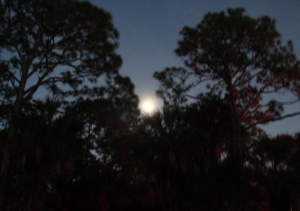 This has been a year for celestial happenings. First, a total eclipse of the sun. And tonight, perigee syzygy!
This has been a year for celestial happenings. First, a total eclipse of the sun. And tonight, perigee syzygy!
Step outside tonight and you’ll notice the Moon is especially large and bright. That’s because the moon is at its closest distance from the Earth. And, it’s not only the last full moon of the year. It happens to be the only supermoon of 2017.
So why is the Moon so close to the Earth? Well, it’s because the Moon circles the Earth on an elliptical orbit. Sometime the Moon is far from the Earth. At other times, like tonight, it is really, really close. The supermoon occurs when the full moon is really, really close. For fans of statistics, tonight’s supermoon will be 222,761 miles from Earth, 1 6,139 miles closer than the average distance of 238,900 miles from the moon to the Earth.
6,139 miles closer than the average distance of 238,900 miles from the moon to the Earth.
Because it is so close, the Moon will be 7% larger and 15% brighter than normal. The moon will be brightest around midnight when it is highest above the horizon, but that, of course, will depend on local cloudiness and weather.
Of course, it may be hard to gauge just how much bigger a supermoon is without seeing a normal-sized moon beside it, sometimes optical illusions can create the appearance of a bigger moon. For instance, if the moon is on the horizon our brains are tricked into viewing the moon larger and brighter than it really is.  This is called a “moon illusion” and results because our brains compare the moon’s size with adjacent objects such as buildings or trees and interprets the moon to be much larger than it actually is.
This is called a “moon illusion” and results because our brains compare the moon’s size with adjacent objects such as buildings or trees and interprets the moon to be much larger than it actually is.
Our last supermoon was on November 14, 2016, and I painted the pictures shown here back then. The 2016 supermoon on November 14, 2016, was the closest the moon got to the Earth since 1948, which won’t happen again until November of 2034, 17 years from now.
 Next year will be a real treat for skywatchers like me. There will be two supermoons in 2018, one on January 2nd and another just a few weeks later on January 31st. The supermoon on January 31st will also be a blue moon as it is the second full moon in the same month.
Next year will be a real treat for skywatchers like me. There will be two supermoons in 2018, one on January 2nd and another just a few weeks later on January 31st. The supermoon on January 31st will also be a blue moon as it is the second full moon in the same month.
NASA has tokened this the supermoon trilogy, with three supermoons occurring in just a few month timespan.








